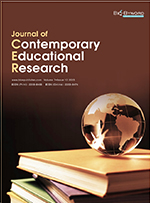Abstract
This paper explores the significant impact of algebraic topology on diverse real-world applications. Starting with an introduction to the historical development and essence of algebraic topology, it delves into its applications in neuroscience, physics, biology, engineering, data analysis, and Geographic Information Systems (GIS). Remarkable applications incorporate the analysis of neural networks, quantum mechanics, materials science, and disaster management, showcasing its boundless significance. Despite computational challenges, this study outlines prospects, emphasizing the requirement for proficient algorithms, noise robustness, multi-scale analysis, machine learning integration, user-friendly tools, and interdisciplinary collaborations. In essence, algebraic topology provides a transformative lens for uncovering stowed-away topological structures in complex data, offering solutions to perplexing problems in science, engineering, and society, with vast potential for future exploration and innovation.
References
Massey WS, 2019, A Basic Course in Algebraic Topology (Vol. 127), Springer, New York.
Andreatta M, 2018, From Music to Mathematics and Backward: Introducing Algebra, Topology, and Category Theory into Computational Musicology, in Imagine Math 6, Springer, Cham, 77–88.
Kempthorne LJA, 2015, Relations between Modern Mathematics and Poetry: Czes?awMi?osz; Zbigniew Herbert; Ion Barbu/Dan Barbilian, thesis, Victoria University of Wellington.
Lord N, 2020, Complex Analysis by Ian Stewart and David Tall (2nd edn.), Cambridge University Press 2018, 389. The Mathematical Gazette, 104(559): 187–189.
Eilenberg S, Steenrod N, 2015, Foundations of Algebraic Topology (Vol. 2193). Princeton University Press, New Jersey.
Fletcher P, Lindgren WF, 2018, Quasi-Uniform Spaces, Routledge, London.
Khovanov M, Robert LH, 2020, Link Homology and Frobenius Extensions II. arXiv Preprint. https://doi.org/10.48550/arXiv.2005.08048
Asok A, Hoyois M, Wendt M, 2018, Affine Representability Results in A^1-Homotopy Theory III: Finite Fields and Complements. arXiv Preprint. https://doi.org/10.48550/arXiv.1807.03365
Bray C, Butscher A, Rubinstein-Salzedo S, 2021, Algebraic Topology, Springer, New York.
Haarmann J, Murphy MP, Peters CS, et al., 2015, Homotopy Equivalence in Finite Digital Images. Journal of Mathematical Imaging and Vision, 2015(53): 288–302.
Robinson J, 2015, Arriving at Urban Policies: The Topological Spaces of Urban Policy Mobility. International Journal of Urban and Regional Research, 39(4): 831–834.
Cisinski DC, 2019, Higher Categories and Homotopical Algebra (Vol. 180), Cambridge University Press, Cambridge.
Houzel C, 1992, The Development of Mathematical Research in France since the Second World War, CEFIPRA.
Fajstrup L, Goubault E, Haucourt E, et al., 2016, Directed Algebraic Topology and Concurrency (Vol. 138), Springer, Berlin.
Barbarossa S, Sardellitti S, 2020, Topological Signal Processing over Simplicial Complexes. IEEE Transactions on Signal Processing, 2020(68): 2992–3007.
Salnikov V, Cassese D, Lambiotte R, 2018, Simplicial Complexes and Complex Systems. European Journal of Physics, 40(1): 014001.
Kühlbrandt W, 2015, Structure and Function of Mitochondrial Membrane Protein Complexes. BMC Biology, 2015(13): 1–11.
Choi S, Oh J, Park JR, et al., 2023, Effective Data Reduction Algorithm for Topological Data Analysis. arXiv Preprint. https://doi.org/10.48550/arXiv.2306.13312
Briot S, Goldsztejn A, 2018, Topology Optimization of Industrial Robots: Application to a Five-Bar Mechanism. Mechanism and Machine Theory, 2018(120): 30–56.
Talalaev DVE, 2021, Tetrahedron Equation: Algebra, Topology, and Integrability. Russian Mathematical Surveys, 76(4): 685.
Tokura Y, Yasuda K, Tsukazaki A, 2019, Magnetic Topological Insulators. Nature Reviews Physics, 1(2): 126–143.
Wu K, Wei GW, 2018, Quantitative Toxicity Prediction using Topology-Based Multitask Deep Neural Networks. Journal of Chemical Information and Modeling, 58(2): 520–531.
Adjed F, Mziou-Sallami M, Pelliccia F, et al., 2022, Coupling Algebraic Topology Theory, Formal Methods, and Safety Requirements Toward a New Coverage Metric for Artificial Intelligence Models. Neural Computing and Applications, 34(19): 17129–17144.
Cang Z, 2018, Algebraic Topology and Machine Learning for Biomolecular Modeling, thesis, Michigan State University.
Izmirlioglu Y, Erdem E, 2023, Qualitative Reasoning about 2D Cardinal Directions using Answer Set Programming. Journal of Artificial Intelligence Research, 2023(77): 1371–1453.
Wang L, O’Connor D, Rinklebe J, et al., 2020, Biochar Aging: Mechanisms, Physicochemical Changes, Assessment, and Implications for Field Applications. Environmental Science & Technology, 54(23): 14797–14814.
Schmidt J, Marques MR, Botti S, et al., 2019, Recent Advances and Applications of Machine Learning in Solid-State Materials Science. npj Computational Materials, 5(1): 83.
